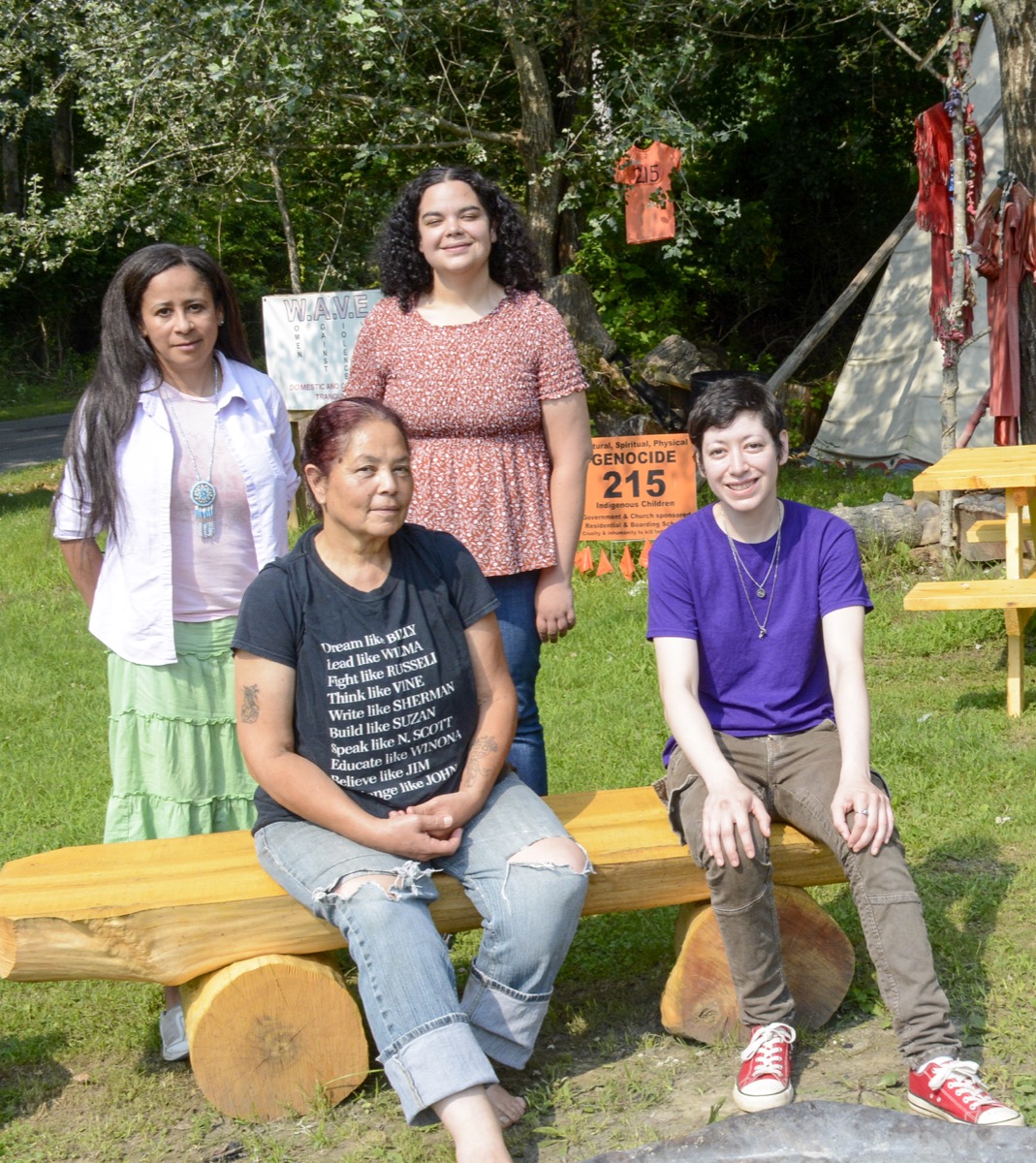On Long Island, A Tribal Nation Faces Growing Pressures
10:06 minutes
 This article is part of The State of Science, a series featuring science stories from public radio stations across the United States. This story features reporting from WSHU Public Radio.
This article is part of The State of Science, a series featuring science stories from public radio stations across the United States. This story features reporting from WSHU Public Radio.

The Hamptons on Long Island are known as a mansion-lined escape for wealthy New Yorkers. But the area is also home to the Native residents of the Shinnecock Tribal Nation. An estimated 1,500 Shinnecock members are left in the U.S., and about half live on the Nation’s territory on Long Island.
As with the rest of the island, Shinnecock Nation is extremely vulnerable to climate change. Receding shorelines threaten to eat up three-quarters of its territory by 2050, adding to the existing threat of development from the Hamptons. This issue of climate change and its impacts around Long Island is the subject of the new podcast, “Higher Ground,” from WSHU Public Radio in Fairfield, Connecticut. One of the stories told in the podcast is that of Tela Troge, Shinnecock tribal sovereignty attorney and kelp farmer, who lives on Shinnecock territory in Long Island.
Tela talks to Ira about seeing climate change and development affect Shinnecock land with her own eyes, and her venture into kelp farming as a tool for nitrogen sequestration.
WSHU’s “Higher Ground” podcast is made possible by the Alan Alda Center for Communicating Science, and the Kavli Foundation.
Invest in quality science journalism by making a donation to Science Friday.
Tela Troge is a Shinnecock tribal attorney and kelp farmer on Shinnecock Territory, New York.
IRA FLATOW: This is Science Friday. I’m Ira Flatow. And now it’s time to check in on the state of science.
SPEAKER 2: This is KPRA News–
SPEAKER 3: For WWNO–
SPEAKER 4: St. Louis Public Radio.
SPEAKER 5: Iowa Public Radio News.
IRA FLATOW: Local science stories of national significance. The Hamptons way out on Long Island are known as an escape for wealthy New Yorkers, but they’re also home to the Shinnecock tribal territory.
JD ALLEN: There are about 1,500 Shinnecock left in the US. About half live on the territory on Long Island. Generations alive today say a lot needs to happen to rebuild the relationship between the tribe and suburbia and the impact on the environment.
IRA FLATOW: That’s JD Allen, host of the podcast Higher Ground from WSHU Public Radio. The podcast is an exploration of the impacts of climate change and development on Long Island. And it takes a look at what communities there are doing to keep up with their changing environment.
JD ALLEN: Three quarters of their territory could be lost to sea level rise by 2050, and more frequent extreme weather will accelerate that process.
TELA TROGE: This has really been at our front door for a lot longer, I think, than the rest of the population. And so we’re really forced to spring into action to mitigate and adapt.
IRA FLATOW: One of the stories told in the podcast is that of my guest Tela Troge, Shinnecock tribal attorney and kelp farmer based on Shinnecock territory on the south shore of Long Island. Thanks so much for joining us.
TELA TROGE: Thank you so much for having me.
IRA FLATOW: Nice to have you. Can you begin to paint for us a picture of why the Shinnecock Nation land is so vulnerable to climate change?
TELA TROGE: Sure. So Shinnecock territory is a Peninsula. We are surrounded on all sides by water. We have about 900 acres of our ancestral territory remaining. And we’re a frontline community seeing a rapid loss of territory due to rising sea level water.
The Shinnecock Nation has experienced a loss of our territory due to climate change, due to rising sea water. We’re facing issues of saltwater intrusion that’s rapidly eroding our shoreline. And we’re seeing nutrient overloads, which is rapidly depleting our traditional way of life, including our aquaculture trade which we depend on for sustenance and sustenance.
IRA FLATOW: What is your agriculture trade? Tell me about that.
TELA TROGE: So, historically, Shinnecock have depended on the water for shellfish, for fishing, for whaling. And today, we see that 99% of the marine life has died, and all of it is tied to excess nitrogen in our water from lack of residential and commercial wastewater treatment, as well as lawn fertilization.
IRA FLATOW: And so what are you doing to combat that? Is there something you can do in that water system?
TELA TROGE: So we are taking the approach of growing sugar kelp, which is a native species, that has the ability to extract excess nitrogen as well as carbon from the water. And so we’re looking at a situation where we’re going to be farming the sugar kelp. And our first season, we’re looking to farm 10,000 pounds of sugar kelp, which could remove up to 36 pounds of nitrogen from our water, from Shinnecock Bay which we depend on the most for fish and shellfish, as well as recreate some of the habitat that’s been lost to hurricanes and storms such as Superstorm Sandy.
IRA FLATOW: So you can make a business out of farming the kelp, but what do you do with the kelp? How do you sell it?
TELA TROGE: So one of the main things that we’re looking at doing is turning the kelp into a fertilizer. So historically, the Shinnecock people used kelp as well as fish for fertilization of our crops. And that’s one of the first things that we taught the European settlers.
We noticed that they were starving; the didn’t have any food. So we showed them how to use seaweed to help cultivate their crops. And seaweed is actually also a really good insulator. So we’ve always use seaweed to insulate our homes. And so that’s something else that we taught the European settlers how to do.
But we’re hoping to replace the fertilizer that is used to artificially maintain a lot of the college campuses on Long Island, the golf courses on Long Island, as well as the homes, their mansions really of millionaires and billionaires that before the COVID-19 pandemic, they really only lived in for a couple of months out of the year, yet, had maintained year round these vast lawns.
And so what was happening was a lot of these folks were shipping in fertilizer from New Jersey. And they’re crossing over the George Washington Bridge and it just had this huge, huge impact. And then the fertilizer was running off into the water and contributing to this nitrogen overload that, in turn, kills all of the marine life. So we’re hoping to use our sugar kelp as fertilizer to kind of reduce that carbon footprint and locally grown or organic product rather than just a chemical pollutant.
IRA FLATOW: So how long do you think it will take for you to see an effect on the nitrogen levels around you?
TELA TROGE: We’re hoping that by 2025, we can activate a network of farmers large enough to produce 200 million pounds of seaweed that will sequester 12,350 tons of CO2 and 412.5 tons of nitrogen each year. And that’s the rate that we need to go out to really begin to mitigate the problem.
IRA FLATOW: I know if I look at the map of Long Island, and I see you’re on Shinnecock, Bay which leads out right into the Atlantic Ocean, I imagine that the sea level rise along with the hurricanes that come by every now and then must devastate and just eat away at the native lands there.
TELA TROGE: It is. It’s absolutely devastating to the Shinnecock territory. We’ve lost a lot of our ancestral land to colonization, to land theft, to the state of New York violating federal laws. But now we’re in this crisis where we’re seeing our territory and our livable land just be completely lost to the sea. And we have estimates by FEMA that by 2050, up to three quarters of our territory could be underwater from a combination of storms and rising sea levels.
IRA FLATOW: Do you think that kelp farming can actually hold back the sea bit?
TELA TROGE: We hope so. We’re using it in conjunction with other methods. We recently completed a coastal rehabilitation project where we’re utilizing other techniques, such as oyster reefs, but we’re hoping that by creating these kelp farms, we’ll create a habitat where oysters can return back.
President Biden just declared the Peconic Bay, which is another body of water that surrounds our territory, a federal disaster zone because of the loss of 99% of the marine life there. And Shinnecock Bay, it’s not in any better shape. 99% of once what lived there no longer can exist.
So we’re hoping that the kelp forests, the kelp farms can bring back these marine bivalves that function as natural filters as well as hurricane protection to protect the shoreline. And it’s not just our shoreline that we’re protecting, it’s all of Long Island and all of these ultra vulnerable communities that are right up on the water.
IRA FLATOW: I had no idea how bad the situation was– 99% gone.
TELA TROGE: Yes. We’re in a true crisis.
IRA FLATOW: Are you getting any support from the non-native residents of the Hamptons who live in those giant mansions?
TELA TROGE: We are hoping that they will support us by purchasing our fertilizer. We also have a really strong partnership with the Sisters of St. Joseph who have a nunnery out in Hampton Bays. And so we are seeing a lot of support from environmentally-conscious neighbors.
IRA FLATOW: Well, as someone who grew up on Long Island and knows a lot about what you’re talking about, I wish you great luck.
TELA TROGE: Thank you.
IRA FLATOW: And I hope it’ll be more than luck that you get and assistance.
TELA TROGE: Thank you so much.
IRA FLATOW: Tela Troge, Shinnecock tribal attorney and kelp farmer based on Shinnecock territory on the south shore of Long Island. And if you’re interested in learning more about climate change and its impacts on Long Island, check out the Higher Ground podcast from our friends at WSHU Public Radio.
Copyright © 2021 Science Friday Initiative. All rights reserved. Science Friday transcripts are produced on a tight deadline by 3Play Media. Fidelity to the original aired/published audio or video file might vary, and text might be updated or amended in the future. For the authoritative record of Science Friday’s programming, please visit the original aired/published recording. For terms of use and more information, visit our policies pages at http://www.sciencefriday.com/about/policies/
 A selection of Science Friday’s podcasts, teaching guides, and other resources are available in the LabXchange library, a free global science classroom open to every curious mind.
A selection of Science Friday’s podcasts, teaching guides, and other resources are available in the LabXchange library, a free global science classroom open to every curious mind.
Kathleen Davis is a producer and fill-in host at Science Friday, which means she spends her weeks researching, writing, editing, and sometimes talking into a microphone. She’s always eager to talk about freshwater lakes and Coney Island diners.
Ira Flatow is the founder and host of Science Friday. His green thumb has revived many an office plant at death’s door.